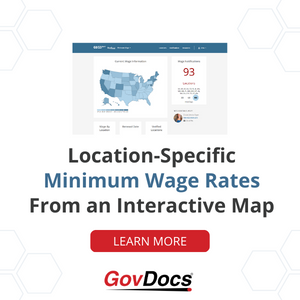EMPLOYMENT LAW NEWS
A Fight for $20: The Nation’s Newest Minimum Wage Push in 2024
By GovDocs
Updated August 2024

Since the Fight for $15 started in 2012, dozens of jurisdictions have passed new minimum wage laws. Many of these are at the city level, where several rates have long since passed the $15 threshold. Now, the Fight for $20 minimum wage push is afoot.
The Fight for $15 has seemingly evolved into the Fight for $20.
It’s been over a decade since hundreds of fast food workers in New York walked off the job, asking for a $15 minimum wage and other improved labor conditions. Since then, the minimum wage movement has expanded. And lawmakers have responded.
The Fight for $15 started in 2012, when dozens of jurisdictions began to pass more generous minimum wage laws. Many of these were at the city level, where several rates have long since passed the $15 threshold.
For example, in April 2024, the minimum wage for California fast food workers was raised to $20, leading to both praise and controversy over the landmark decision. Meanwhile, with inflation still a concern and little movement on a federal rate increase, other jurisdictions continue the Fight for $20, with additional bills under consideration in New York, Massachusetts, and elsewhere.
Looking for 2025 Minimum Wage Rates by State? View our latest blog
What is the fight for $20 minimum wage?
For a bit of background, long before the Fight for $20, a Fight for $15 was already underway. As of July 2024, seven states hit or passed the previous hallmark number of $15:
- California – $16
- Connecticut – $15.69
- Maryland – $15 (Maryland minimum wage update)
- Massachusetts – $15
- New Jersey – $15.13 (large employers)
- New York – Multiple New York minimum wage rates apply, all are at or over $15
- Washington – $16.28
- Washington, D.C. – $16.10 (included here for clarity)
So, in a way, the Fight for $20 is the successor of these efforts , especially for employers that have locations in progressive states. At the same time, several states have scheduled increases to reach a $15 minimum wage in the coming years. Plus, a number of cities are beyond that figure, including many in California, along with Seattle. In case you’re wondering, Washington has the highest standard minimum wage in the nation.
Fight for $20: What’s Next?
In the wake of these increases, activists have launched efforts to push for a minimum wage of $20 or higher. In places like New York State and Massachusetts, lobbyists and other progressive groups are asking legislators to rethink existing minimum wage policy. Meanwhile, others say tying minimum wage increases to the applicable Consumer Price Index is a more palatable way to raise wages for workers.
“Indexing is definitely a really good policy to make sure that workers’ paychecks are not as impacted by what we’re going through right now,” in terms of inflation, the National Employment Law Project’s Yannet Lathrop told Politico. In fact, indexing is an increasingly common practice in the United States. As of August 2024, states with indexed rates in place include:
- Alaska – In effect; current rate: $11.73
- Arizona – In effect; current rate: $14.35
- Colorado – In effect; current rate: $14.42
- Maine – In effect; current rate: $14.15
- Minnesota – In effect; current rate: $10.85 (for large employers); $8.85 (for small employers).
- Missouri – Effective Jan. 1, 2024; current rate: $12.30
- Montana – In effect; current rate: $10.30
- New York – In effect; current rate: $16.00
- Ohio – In effect; current rate: $10.45
- Oregon – In effect; $15.95 per hour inside the Portland urban growth boundary, $13.70 per hour in nonurban counties, and $14.70 in other areas of the state. Unique to Oregon, these numbers are based on population density.
- South Dakota – In effect; current rate: $11.20
- Vermont – In effect; current rate: $13.67
Still, these gradual increases often aren’t enough, some labor advocates argue, which has helped spur the idea that the Fight for $15 should become the Fight for $20 for minimum wage earners in the U.S.
Minimum Wage Compliance Resources
Minimum Wage in the U.S.
Employers that operate across the country already know of the challenges of managing minimum wage rates. From industry-specific rates and tipped wages, indexing and more, the complexities of minimum wage continue to grow. Add in ballot measures and other groups lobbying for a Fight for $20, and the difficulties for employers to track and apply minimum wage rates will likely be the norm in the future.
Meanwhile, these laws can be more complicated than simply knowing the rates. Cook County, Ill., allows cities to opt in or out of its ordinance. And Oregon minimum wage applies its rate based on population density. Plus, employers can’t always rely on regular timeframes for minimum wage increases, as not all jurisdictions update their minimum wage rate on Jan. or July 1 of each year.
These and other unique minimum wage laws should keep employers on their toes moving forward.
Conclusion
Should the Fight for $20 gain footing, as the previous Fight for $15 did, large employers would be wise to keep an eye on jurisdictions where they have locations, especially in more progressive areas. California, New York and the coasts of the U.S. are generally at the forefront of employment law trends. How these jurisdictions approach minimum wage could lead to more laws and compliance concerns in the months and years ahead. On the other side of the coin, it is worth noting that several states still follow the federal minimum wage, which hasn’t increased in more than a decade. As of July 2024, they are:
- Alabama
- Georgia
- Iowa
- Idaho
- Indiana
- Kansas
- Kentucky
- Louisiana
- Mississippi
- North Carolina
- North Dakota
- New Hampshire
- Oklahoma
- Pennsylvania
- South Carolina
- Tennessee
- Texas
- Utah
- Wisconsin
- Wyoming
At the same time, some of these states have explored new rates. Notably, Pennsylvania has renewed a push for a new minimum wage rate. Even still, it’s incumbent upon employers to monitor and track minimum wage rates, especially in light of this new Fight for $20.
This Employment Law News blog is intended for market awareness only, it is not to be used for legal advice or counsel.
Keep Informed
with GovDocs Employment Law News
Who is GovDocs?
GovDocs simplifies employment law compliance for large employers in the U.S. and Canada. The GovDocs software platform integrates three solutions in one convenient place to help you master the employment laws impacting your business. Whether you manage a labor law posters, minimum wage or paid leave program, our products cut through research time, provide proactive insights into the everchanging landscape of employment laws and reduce the risk of noncompliance. The company is headquartered in Eagan, Minn.
The GovDocs Poster Store simplifies posting compliance for employers with less than 30 locations across all industries, offering a variety of posting products to meet your labor law compliance needs.




